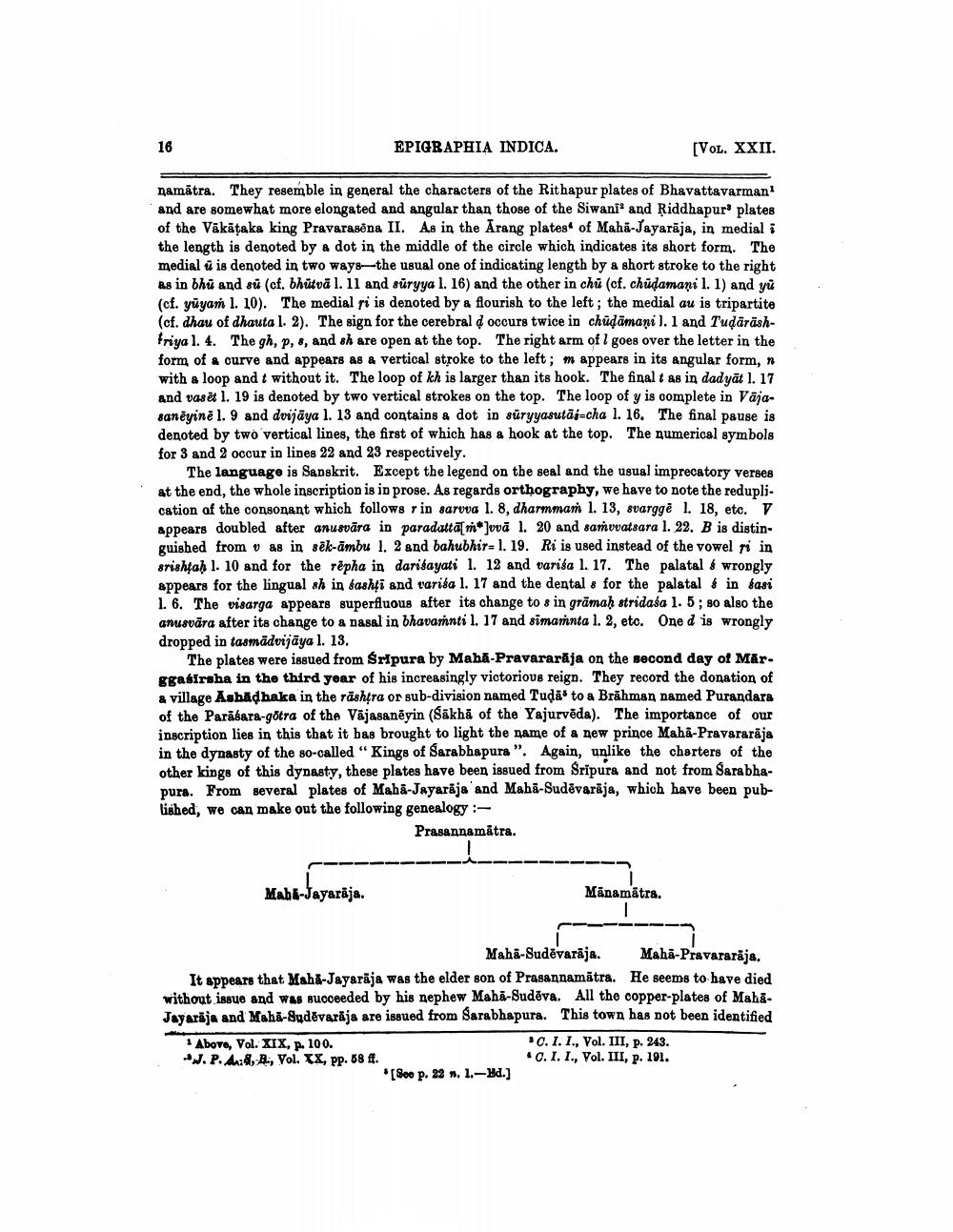________________
16
[VOL. XXII.
namatra. They resemble in general the characters of the Rithapur plates of Bhavattavarman1 and are somewhat more elongated and angular than those of the Siwani' and Riddhapur plates of the Vākāṭaka king Pravarasena II. As in the Arang plates of Maha-Jayaraja, in medial i the length is denoted by a dot in the middle of the circle which indicates its short form. The medial u is denoted in two ways-the usual one of indicating length by a short stroke to the right as in bhu and sú (cf. bhūtvā 1. 11 and sūryya 1. 16) and the other in chu (cf. chudamani 1. 1) and yu (cf. yuyam 1. 10). The medial ri is denoted by a flourish to the left; the medial au is tripartite (cf. dhau of dhauta 1. 2). The sign for the cerebral d occurs twice in chudamani 1. 1 and Tuḍārāshtriya 1. 4. The gh, p, s, and sh are open at the top. The right arm of 1 goes over the letter in the form of a curve and appears as a vertical stroke to the left; m appears in its angular form, n with a loop and t without it. The loop of kh is larger than its hook. The final t as in dadyat 1. 17 and vaset 1. 19 is denoted by two vertical strokes on the top. The loop of y is complete in Vājasaneyině 1. 9 and dvijaya 1. 13 and contains a dot in suryyasutai-cha 1. 16. The final pause is denoted by two vertical lines, the first of which has a hook at the top. The numerical symbols for 3 and 2 occur in lines 22 and 23 respectively.
The language is Sanskrit. Except the legend on the seal and the usual imprecatory verses at the end, the whole inscription is in prose. As regards orthography, we have to note the reduplication of the consonant which follows rin sarvva 1. 8, dharmmam 1. 13, svargge 1. 18, etc. V appears doubled after anusvara in paradatta[m]vva 1. 20 and samvvatsara 1. 22. B is distinguished from as in sek-ambu 1. 2 and bahubhir- 1. 19. Ri is used instead of the vowel ri in srishṭaḥ 1. 10 and for the repha in dariśayati 1. 12 and varisa 1. 17. The palatal & wrongly appears for the lingual sh in sashți and varisa 1. 17 and the dental s for the palatal in sasi 1. 6. The visarga appears superfluous after its change to s in gramaḥ stridasa 1. 5; so also the anusvāra after its change to a nasal in bhavaṁnti 1. 17 and simamnta 1. 2, etc. One d is wrongly dropped in tasmädvijāya 1. 13.
The plates were issued from Sripura by Maha-Pravararaja on the second day of Mar. ggasirsha in the third year of his increasingly victorious reign. They record the donation of a village Ashadhaka in the rashtra or sub-division named Tuda' to a Brahman named Purandara of the Parasara-götra of the Vajasaneyin (Säkha of the Yajurvēda). The importance of our inscription lies in this that it has brought to light the name of a new prince Maha-Pravararāja in the dynasty of the so-called "Kings of Sarabhapura". Again, unlike the charters of the other kings of this dynasty, these plates have been issued from Sripura and not from Sarabhapura. From several plates of Maha-Jayaraja and Maha-Sudevaraja, which have been published, we can make out the following genealogy :
Prasannamātra.
Maha-Jayaraja.
EPIGRAPHIA INDICA.
1 Above, Vol. XIX, P. 100. J. P. A, A, Vol. XX, pp. 58 ff.
Maha-Sudēvarāja.
Maha-Pravararāja.
It appears that Maha-Jayaraja was the elder son of Prasannamatra. He seems to have died without issue and was succeeded by his nephew Maha-Sudeva. All the copper-plates of MahaJayaraja and Maha-Sudevaraja are issued from Sarabhapura. This town has not been identified
Manamatra. I
[See p. 22 n. 1.-Ed.]
C. I. I., Vol. III, p. 243. C. I. I., Vol. III, p. 191.




